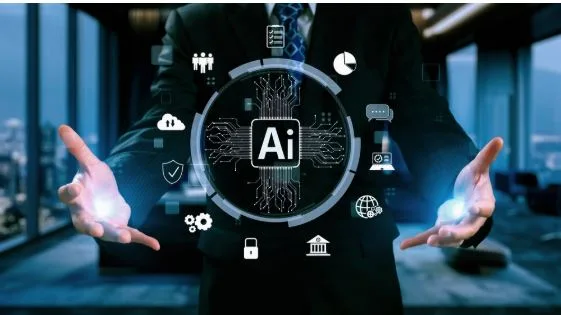AI-Powered Enterprises: How Artificial Intelligence Is Transforming Business in 2025
By 2025, artificial intelligence will no longer be a futuristic promise – it will be a competitive necessity. Organizations across industries are using AI to streamline operations, improve decision-making, and discover new sources of value. IDC projects that global AI spending will surpass $500 billion by 2025. This growth is driven by enterprises embedding intelligent systems into every layer of their businesses, from supply chain forecasting to customer service automation.
However, as adoption accelerates, a gap is emerging between companies that use AI experimentally and those that leverage it as a strategic differentiator. The difference lies not in access to technology but in how it’s implemented. Off-the-shelf tools can deliver short-term wins, but real transformation requires solutions that are tailored to a company’s unique data, goals, and workflows.
This is why partnering with the right AI software development company has become a cornerstone of digital strategy. Custom-built AI systems that are designed, trained, and integrated for specific business contexts are redefining operational intelligence in 2025.
The State of AI Adoption in 2025
AI adoption has matured dramatically since the early hype cycles. According to McKinsey’s 2025 State of AI report, 72% of global enterprises now use at least one AI application in daily operations. What began as isolated automation projects has evolved into enterprise-wide initiatives spanning analytics, logistics, HR, and customer experience.
Yet the road to successful AI implementation is rarely smooth. Businesses face persistent challenges:
- Integration complexity: Many legacy systems aren’t designed to support modern data pipelines or machine learning models.
- Data readiness: High-quality, labeled data remains the fuel for AI and many organizations are still learning to manage it effectively.
- ROI measurement: Executives struggle to quantify AI’s financial impact beyond efficiency metrics.
In this environment, strategic alignment is key. The most successful adopters treat AI not as an experimental add-on but as a core business capability, one that demands strategic planning, strong data foundations, and long-term partnerships with experts who understand both technology and business value.
From Automation to Intelligence
The narrative around AI has shifted. Businesses have moved past using AI merely to automate repetitive tasks; they now deploy it to augment human decision-making and create intelligent systems that anticipate, learn, and innovate.
- Manufacturing: Predictive maintenance powered by machine learning reduces downtime by forecasting equipment failures before they occur.
- Healthcare: AI-driven analytics accelerate diagnostics and personalize treatment recommendations.
- Fintech: Advanced models detect anomalies in real time to prevent fraud and optimize credit risk assessment.
- Retail: Generative AI applications craft individualized product recommendations and marketing content, creating hyper-personalized customer journeys.
These examples illustrate a crucial evolution: AI is becoming the strategic brain of modern organizations. With custom AI software development, companies can embed predictive analytics, cognitive automation, and generative capabilities directly into their workflows, transforming processes that once relied on instinct into data-driven systems that continuously learn and adapt.
The Build vs. Buy Dilemma
As AI matures, many organizations face a familiar question: should they build their AI systems from scratch or buy pre-built solutions?
Off-the-shelf AI tools have value – they’re affordable, fast to deploy, and suitable for standard tasks like image recognition or chat automation. However, they often fall short when scalability, accuracy, or differentiation matter. Their algorithms are generic by design and rarely align perfectly with an enterprise’s data structure, compliance requirements, or strategic objectives.
That’s where custom enterprise AI solutions come in. Building AI tailored to your organization ensures:
- Models are trained on proprietary data, improving precision and competitive advantage.
- Systems integrate seamlessly with your existing IT infrastructure.
- Security, privacy, and compliance are built into every layer.
- The solution evolves as your business and market dynamics change.
The AI Development Lifecycle in Practice
AI success doesn’t come from coding alone – it’s the result of a disciplined development lifecycle combining technical excellence with business understanding.
- Data Strategy: Every AI initiative begins with data. Identifying, collecting, and cleaning relevant datasets is critical to ensuring model accuracy and ethical use.
- Model Design and Training: Machine learning development teams experiment with algorithms – supervised, unsupervised, or reinforcement learning – based on the problem’s nature. They fine-tune models until they deliver reliable, bias-free predictions.
- Integration and Testing: AI systems must be embedded into existing business software, CRMs, or ERPs without disrupting daily operations. Integration testing ensures smooth data exchange and user adoption.
- Deployment and Monitoring: Once live, continuous monitoring tracks performance drift and updates models as new data emerges.
- Governance and Explainability: In 2025, responsible AI is a priority. Transparent, explainable models help businesses comply with evolving regulations like the EU AI Act while maintaining customer trust.
Real-World Impact & ROI
The tangible results of AI adoption are compelling. Enterprises that have successfully integrated AI into their operations are reporting measurable benefits across productivity, cost savings, and innovation.
- Operational Efficiency: AI-driven automation of back-office workflows (such as document processing or support ticket triage) reduces administrative costs by up to 40%, according to Deloitte.
- Faster Decision-Making: Predictive analytics empower executives to act on real-time insights rather than retrospective reports transforming planning from reactive to proactive.
- Revenue Growth: Retailers leveraging AI personalization see 10–15% increases in average order value. Manufacturers using AI forecasting report more accurate inventory management and reduced waste.
- Innovation Acceleration: Generative AI applications are now co-creating product designs, writing code, and generating content, thus shortening development cycles and expanding creative capacity.
Importantly, these outcomes depend on more than algorithms; they require the right execution strategy. That’s where AI consulting services and machine learning development expertise make all the difference.
For example, Intersog’s global engineering teams help organizations integrate AI into critical workflows, whether through computer vision in quality control, NLP for customer analytics, or recommendation engines for digital platforms. Their approach ensures technology investments translate into measurable ROI, not experimental prototypes.
Conclusion: Building the Future of Intelligent Enterprises
By 2025, the most successful companies aren’t those that merely use AI – they are those that think with AI. They treat it not as a tool, but as an extension of their organizational intelligence, shaping strategy, creativity, and customer engagement.
However, achieving that level of integration requires more than enthusiasm; it demands technical depth, ethical design, and long-term vision. Choosing the right AI software development agency ensures your business builds systems that are secure, scalable, and strategically aligned with your goals.






